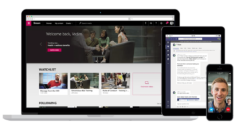There are no two ways about it: video content requires budget, and a lot of it.
First of all, there are the costs associated with creating the content. This can include everything from event production of a CEO town hall to populating an on-demand training video library, with all the staff time, scripting, recording, and editing that entails. Next, you have to factor in the cost of serving up your content, such as the need for extra hardware or a software ECDN solution like Kollective to alleviate demand on your network. Finally, someone needs to spend time managing the content and responding to any network performance issues.
However, just because something requires a big budget doesn’t make it a poor purchase. When compared to producing a large, in-person town hall event or conducting live, on-going training, video is far more cost-effective and scalable.
But as a large line item on the comm’s team budget, video will always require protection from cuts and rationalization for growth. That’s why it’s essential your team measures the ROI of your video efforts if you hope to prove that video is worth the time and money your team is investing.
While this sounds obvious, it’s far from common practice: according to ITSMA , 74% of organizations were unable to measure or report how their marketing efforts impacted their business. When it comes to video, that means the vast majority of comms teams are producing live CEO video presentations to employees worldwide or creating massive training libraries without any insight into who, if anyone, is actually watching.
That’s where analytics come in. A robust analytics platform like Kollective IQ can help you measure the performance of your live video events and on-demand content in real time. By analyzing specific video content and your longer-term trends, you’ll be able to build your case for continued video investment while making the adjustments necessary to improve performance.
You can do a number of things with video metrics. First, and most importantly, you can determine the performance of your videos. Metrics like unique event views and average view duration can show how many people watched your content and for how long. With those numbers alone, you can then determine your overall content engagement. Compare your video costs against what it would take to achieve similar engagement without video to then prove ROI to your leadership team.
But video ROI is just the beginning. There’s a larger network ROI case you can make. Your video performance can act as a proxy for your network performance; if a video is buffering, that means there is a bottleneck in your network that is impacting the flow of your other critical business data. Use your analytics to measure network performance and tie improvements in data flow to business metrics like productivity.
To prove the ROI of your video strategy, keep in mind the following:
- Analytics need data: If you’re not collecting data, you have nothing to measure. But surface-level, basic metrics don’t always tell the whole story. Your analytics should be able to drill down deep into the performance of each asset to provide the data required to unlock insights.
- Invest in insights: To improve ROI, you have to not only measure the data but use it to take action. To use it, though, you have to understand it. Dashboards can make it easier to collect your data together in a way that makes it simple to analyze successes and identity issues so you can make informed strategic decisions into your content and network.
- Proving ROI isn’t a one-time event: Analytics should be an ongoing practice. You should be looking at the performance of your content over time to make sure you’re seeing improvement or catching minor issues before they turn into something major.
- Don’t forget to prove it: Make sure you share your video performance with your leaders. They likely don’t speak video, so don’t just give them raw metrics. Integrate your video performance data into your business analytics to show how video is driving business performance, and then use data visualization to make it easy for leaders to see the success for themselves.
FOLLOW KOLLECTIVE TECHNOLOGY

Kollective for Microsoft 365
Kollective scales and secures your network for the modern workplace.


Related Blog Posts
5 Ways Your Enterprise Company Could Benefit from Video All-Hands Meetings
Town hall meetings. Round-ups. All-hands meetings. Whatever your company calls it, most businesses have some iteration of the all-hands meeting, which exists to keep employees at all levels in the loop on current initiatives, progress, growth and company news. These…
Are Distribution Points Holding Your Remote Offices Back?
When it comes to large, distributed enterprises like retailers or banks, every location has its own data challenges to overcome. Tier 1 locations, like a global headquarters, can have thousands of employees in one building, while some large corporate campuses may…
3 Roadblocks Keeping You From Corporate Video Success
When it comes to enterprise video, internal communications teams always begin with the best of intentions. They envision live video being used to connect corporate leaders with offices around the world so the CEO can deliver her vision live instead over email. Or…
The post How To Prove ROI Of Video With Analytics appeared first on Kollective Technology .




